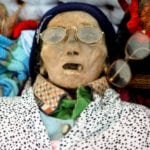 Animals
Animals  Animals
Animals  Weird Stuff
Weird Stuff 10 Weird Things People Used to Do at New Year’s
 Our World
Our World 10 Archaeological Discoveries of 2025 That Refined History
 Weird Stuff
Weird Stuff 10 Fascinating Facts You Might Not Know About Snow
 Miscellaneous
Miscellaneous Top 10 Things Crypto Was Supposed to Change & What Actually Did
 History
History 10 Huge Historical Events That Happened on Christmas Eve
 Music
Music 10 Surprising Origin Stories of Your Favorite Holiday Songs
 History
History 10 Less Than Jolly Events That Occurred on December 25
 Weird Stuff
Weird Stuff 10 Funny Ways That Researchers Overthink Christmas
 Politics
Politics 10 Political Scandals That Sent Crowds Into the Streets
 Animals
Animals 10 Species That Refused to Go Extinct
 Weird Stuff
Weird Stuff 10 Weird Things People Used to Do at New Year’s
 Our World
Our World 10 Archaeological Discoveries of 2025 That Refined History
Who's Behind Listverse?

Jamie Frater
Head Editor
Jamie founded Listverse due to an insatiable desire to share fascinating, obscure, and bizarre facts. He has been a guest speaker on numerous national radio and television stations and is a five time published author.
More About Us Weird Stuff
Weird Stuff 10 Fascinating Facts You Might Not Know About Snow
 Miscellaneous
Miscellaneous Top 10 Things Crypto Was Supposed to Change & What Actually Did
 History
History 10 Huge Historical Events That Happened on Christmas Eve
 Music
Music 10 Surprising Origin Stories of Your Favorite Holiday Songs
 History
History 10 Less Than Jolly Events That Occurred on December 25
 Weird Stuff
Weird Stuff 10 Funny Ways That Researchers Overthink Christmas
 Politics
Politics 10 Political Scandals That Sent Crowds Into the Streets
Top 10 Outdated Christian Beliefs
Most Christians are not as bull headed and afraid of change as most people think. Christianity hasn’t held on to all of the same beliefs over the two thousand years it’s existed. As times changed, Christianity has also changed and, while it’s core beliefs have always been solid, some of the stranger things on the fringes have come and gone. Here’s a list of some of the stranger early beliefs that Christians have since abandoned.

Many of the more bizarre beliefs on this list (and many still accepted by some denominations) come from books of the Bible that were accepted by some early Christian sects (such as the Gnostics), but were later found to be fraudulent. The Book of Enoch was a chronicle of fallen angels who gave people forbidden knowledge, but was later proven to be written by those who claimed to have “discovered” it. Another book, the Gospel of Thomas, chronicled the childhood of Jesus. It recounts him bringing clay birds to life, and resurrecting a dead playmate who fell out of a building. However, this account was shown to be written centuries after the death of Christ and has no corroborating documents. More recently the Gospel of Judas surfaced, supposedly penned by Jesus’ betrayer Judas Iscariot, but was soon after proved a fraud, like the others.

The Bible wasn’t always as available as it is now, in fact, in the middle ages, some Bibles were chained up to prevent their theft – the most famous chained Bible was the Great Bible of King Henry VIII. This is largely due to the fact that a full bible was incredibly expensive (having been written out by hand by monks). The Bible was considered the holy word of God, and as most common folk were illiterate, it was deemed an unnecessary expense (and waste) for them to have copies of the Bible – especially as it was read every day in Churches (see item 9). Even after the Bible was printed on mechanical type, there was vast controversy about who should be able to read the bible, for hundreds of years. Many blame this controversy for the bloody 30-year war fought between the Catholics and the protestants. In modern times, Christians believe not only in the right of everyone to read and study the Bible, but the importance of Bible study and knowledge. To the point where modern Christian missionaries will risk their lives to smuggle Bibles into countries where they are illegal (including, believe it or not, Saudi Arabia).

I’m sure anyone reading this list is familiar with the “Occult” or the practice of arcane magic and spiritualism. While nowadays Christianity and the Occult are very adversarial, when the Occult movement first started it was considered harmless, even healthy. In the late 19th century, seeing a psychic was considered harmless fun, and conducting a seance wasn’t considered evil or wrong in any way (though it was always considered sinful in the Catholic Church). This despite the fact that the occult and spiritual arts are quite explicitly forbidden by the Bible. Later in the 1900s, with the rise of the nastier occultists like Alistair Crowley, the Occult once again began being condemned.

The early Christian church was a bit of a mess for a while. While they held the central belief in Christ as the Son of God and his sacrifice, many still struggled with the idea of the God of Abraham being the only Deity. The scriptures at the time did not explicitly exclude the existence of other “gods”, and even made mention of several other deities (namely demons) such as Baal. However, while the early scripture acknowledges that some believe in these other gods, it never validates the deity’s existence. This belief was actually dispelled before the canonical Bible was finished, with the Apostle Saint Paul scolding early churches for acknowledging other gods in his letters, as well as Saint Peter refusing them to allow the image of the Christian God to be displayed alongside the image of the Roman gods.

In years past, it was common knowledge that Christ was a European looking man, with brown hair and fair features. There were a number of other depictions, but they were almost never considered canonical. In thousands of paintings and statues Jesus is depicted as a caucasian, and the early church took this as the image of Christ without any real proof of what Jesus would look like. However, most modern Christians accept that Jesus likely looked different than our image of him. While most faiths keep the white Jesus for tradition’s sake (as seen above – Christ the King), it’s widely accepted that he was actually a Galilean who, to us, would appear as a modern middle easterner. There is also a broad modern movement that theorizes that Jesus was Ethiopian.

In the very early days of Christianity, there were a few carry-overs from older mythology. One was the belief in cynocephaly (see item 5), or people with the heads of dogs. It was thought that many of the more distant peoples, like central Africans or Indians, had the heads of dogs, many believing that these people would go back to normal once baptized. Different saints who are said to be from distant lands, like St Christopher were depicted with a dog’s head (see above). There was even myths about descendants of Cain, who inhabited Canaan before the Israelis, that “barked and ate human flesh”. Marco Polo was said to be surprised he didn’t see any dog-headed people in China, though he claims many people he talked to had encountered “dog headed barbarians” in Asia.

In the late 70s and early 80s, many Christians believed that there was a vast Satanic conspiracy who’s purpose was to recruit children into their ranks. Christians believed that Satanists had hidden messages in cartoons, games and popular music meant to drive children to the satanic church where they would be used for pornography, prostitution and even sacrifices. Christians claimed there were hidden satanic chants in rock songs, cartoons like He-man were meant to “replace God” and contained “Intentional Occult References” one Christian writer even saying the cartoon Rainbow Brite was “Graphically violent, and filled with Satanic imagery”. This trend largely was discredited and, when confronted by Christian leaders, many musicians and animators were baffled by the accusations.

In the 13th century, a radical Christian denomination popped up, known as the “flagellants” who believed that the best way to absolve sin was to beat yourself silly with whips, switches and other nasty, painful devices to imitate the beating of Christ. While the Pope quickly condemned this practice, “Mortification of the flesh” (see item 3) in moderation was common from the very first days of the Church. Later, in the 15th century, the puritans briefly practiced flagellation, as was recorded in Hawthorn’s novel “The Scarlet Letter”. I was somewhat reluctant to include this one since self-flagellation does still continue in the Catholic Church amongst various religious orders and amongst some cultures in South America.

In the middle ages a few greedy Bishops decided to make some extra cash by selling indulgences. Indulgences are special prayers which remit part, or all, of the punishment owed for serious sins; indulgences have no effect if the person has not confessed his sins. This selling of indulgences (which invalidated them, in fact) went on for quite some time before the Pope got wind of it and banned it. Indulgences have not been sold since, but the scandalous behavior of those Bishops has them a very well known practice from the Middle Ages. The Catholic Church still practices the use of indulgences, with all modern Popes introducing new ones during their reigns.

The Early Church (mainly the Gnostic sects) believed that Adam actually had another wife before Eve. According to several Apocryphal books of the Bible, Lilith was created at the same time and from the same dust as Adam. She refused to be subservient to Adam, and eventual mated with an Archangel named Samiel, and was subsequently expelled from the Garden of Eden. Many early Jewish and Christian myths deal with Lilith, mostly dealing with the eventual offspring of her and Samiel. Many believe their offspring turned out to be the semi-human creatures of Greek myths, like the Centuar and Minotuar. Others believe they became vampires. Later cults and racist groups believe that all non-Caucasian are decedents of Lilith or “Lillam”.








